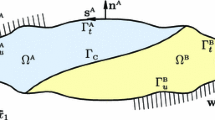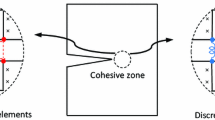Abstract
Brittle Griffith-type delamination of compounds is deduced by means of Γ-convergence from partial, isotropic damage of three-specimen-sandwich-structures by flattening the middle component to the thickness 0. The models used here allow for nonlinearly elastic materials at small strains and consider the processes to be unidirectional and rate-independent. The limit passage is performed via a double limit: first, we gain a delamination model involving the gradient of the delamination variable, which is essential to overcome the lack of a uniform coercivity arising from the passage from partial damage to delamination. Second, the delamination gradient is suppressed. Noninterpenetration- and transmission-conditions along the interface are obtained.

Similar content being viewed by others
References
Adams, R.A.: Sobolev Spaces. Academic Press, New York (1975)
Allix, O.: Interface damage mechanics: Application to delamination. In: Allix, O., Hild, F. (eds.) Continuum Damage Mechanics of Materials and Structures, pp. 295–325. Elsevier, Amsterdam (2002)
Allix, O., Corigliano, A.: Modeling and simulation of crack propagation in mixed-modes interlaminar fracture specimens. Int. J. Fract. 77, 111–140 (1996)
Ambrosio, L., Fusco, N., Pallara, D.: Functions of Bounded Variation and Free Discontinuity Problems. Oxford University Press, Oxford (2005)
Bonetti, E., Bonfanti, G., Rossi, R.: Global existence for a contact problem with adhesion. Math. Methods Appl. Sci. 31, 1029–1064 (2008)
Bonetti, E., Bonfanti, G., Rossi, R.: Thermal effects in adhesive contact: Modelling and analysis. Nonlinearity 22(11), 2697–2731 (2009)
Bouchitté, G., Mielke, A., Roubíček, T.: A complete-damage problem at small strain. Z. Angew. Math. Phys. 60, 205–236 (2009)
Dacorogna, B.: Direct Methods in the Calculus of Variations, 2nd edn. Springer, Berlin (2000)
Dal Maso, G.: An Introduction to Γ-Convergence. Birkhäuser, Boston (1993)
Dal Maso, G., Francfort, G., Toader, R.: Quasistatic crack growth in nonlinear elasticity. Arch. Ration. Mech. Anal. 176(2), 165–225 (2005)
De Borst, R., Schipperen, J.H.A.: Computational methods for delamination and fracture in composites. In: Allix, O., Hild, F. (eds.) Continuum Damage Mechanics of Materials and Structures, pp. 295–325. Elsevier, Amsterdam (2002)
Elstrodt, J.: Maß- und Integrationstheorie, 3rd edn. Springer, Berlin (2002)
Federer, H.: Geometric Measure Theory. Springer, Berlin (1969)
Francfort, G., Larsen, C.: Existence and convergence for quasi-static evolution in brittle fracture. Commun. Pure Appl. Math. 56(10), 1465–1500 (2003)
Francfort, G., Mielke, A.: Existence results for a class of rate-independent material models with nonconvex elastic energies. J. Reine Angew. Math. 595, 55–91 (2006)
Freddi, F., Frémond, M.: Damage in domains and interfaces: A coupled predictive theory. J. Mater. Struct. 1(7), 1205–1233 (2006)
Frémond, M.: Contact with adhesion. In: Moreau, J.J., Panagiotopoulos, P.D., Strang, G. (eds.) Topics in Nonsmooth Mechanics, pp. 157–186. Birkhäuser, Basel (1988)
Giacomini, A.: Ambrosio-Tortorelli approximation of quasi-static evolution of brittle fracture. Calc. Var. Partial Differ. Equ. 22, 129–172 (2005)
Griffith, A.A.: The phenomena of rupture and flow in solids. Philos. Trans. R. Soc. Lond. A 221, 163–198 (1921)
Jantscher, L.: Distributionen. de Gruyter, Berlin (1971)
Ladeveze, P.: A damage computational method for composite structures. Comput. Struct. 44, 79–87 (1992)
Lewis, J.L.: Uniformly fat sets. Trans. Am. Math. Soc. 308(1), 177–196 (1988)
Mainik, A., Mielke, A.: Existence results for energetic models for rate-independent systems. Calc. Var. Partial Differ. Equ. 22, 73–99 (2005)
Marcus, M., Mizel, V.J.: Absolute continuity on tracks and mappings of Sobolev spaces. Arch. Ration. Mech. Anal. 45, 294–320 (1972)
Mielke, A., Roubíček, T., Stefanelli, U.: Γ-limits and relaxations for rate-independent evolutionary problems. Calc. Var. Partial Differ. Equ. 31, 387–416 (2008)
Point, N., Sacco, E.: A delamination model for laminated composites. Int. J. Solids Struct. 33(4), 483–509 (1996)
Point, N., Sacco, E.: Delamination of beams: an application to the DCB specimen. Int. J. Fract. 79, 225–247 (1996)
Roubíček, T., Scardia, L., Zanini, C.: Quasistatic delamination problem. Contin. Mech. Thermodyn. 21(3), 223–235 (2009)
Thomas, M.: Rate-independent damage processes in nonlineary elastic materials. PhD thesis, Humboldt-Universität zu Berlin (2010)
Thomas, M., Mielke, A.: Damage of nonlinearly elastic materials at small strain: existence and regularity results. Z. Angew. Math. Mech. 90(2), 88–112 (2010)
Acknowledgements
The authors are thankful to Dr. D. Knees for many fruitful discussions and valuable comments. The article arose out of M.T.’s visit of the ‘Nečas center for mathematical modeling’, supported by LC 06052 (MŠMT ČR). M.T. was also supported by the DFG within the RTG 1128 ‘Analysis, Numerics and Optimization of Multiphase problems’. T.R. was supported by grants A 100750802 (GA AV ČR), 201/10/0357 and 201/09/0917 (GA ČR), MSM 21620839, and 1M06031 (MŠMT ČR), and from the research plan AV0Z20760514 (ČR). The research of A.M. was partially supported by DFG within the subproject C18 of Matheon.
Author information
Authors and Affiliations
Corresponding author
Appendix: Abstract Γ-Convergence Result
Appendix: Abstract Γ-Convergence Result
In [25] the theory of Γ-convergence was adapted to the framework of the energetic formulation of rate-independent processes. In the following we introduce sufficient conditions guaranteeing that a subsequence of energetic solutions of the approximating systems \((\mathcal{Q},{\mathcal{E}}_{j},{\mathcal{R}}_{j})\) converges to an energetic solution of the limit system \((\mathcal{Q},{\mathcal{E}}_{\infty},{\mathcal{R}}_{\infty})\). Let the topology for the convergence of the energetic solutions be denoted by \(\mathcal{T}\). Then we want to obtain that \(q_{j}(t)\overset{\mathcal{T}}{\to}q(t)\) for all t∈[0,T].
For all \(j\in\mathbb{N}_{\infty}=\mathbb{N}\cup\{\infty\}\) we introduce the stable sets \({\mathcal{S}}_{j}(t):=\{q\in\mathcal{Q}\,|\,{\mathcal {E}}_{j}(t,q)<\infty ,\,\forall\tilde{q}=(\tilde{u},\tilde{z}):{\mathcal{E}}_{j}(t,q_{j})\leq{\mathcal{E}}_{j}(t,\tilde{q})+\mathcal {R}_{j}(\tilde{z}-z_{j})\}\).
In order to ensure the Γ-convergence of the systems \((\mathcal{Q},{\mathcal{E}}_{j},{\mathcal{R}}_{j})_{j\in\mathbb{N}}\) the following conditions have to be satisfied by the energy functionals \({\mathcal{E}}_{j}:[0,T]\times\mathcal{Q}\to \mathbb {R}_{\infty}\) for all \(j\in\mathbb{N}_{\infty}\).



Furthermore the dissipation distances \(\mathcal{D}_{j}:\mathcal {Z}\times\mathcal{Z}\to [0,\infty]\) with \(\mathcal{D}_{j}(z,\tilde{z})={\mathcal{R}}_{j}(\tilde{z}-z)\) for all \(z,\tilde{z}\in\mathcal{Z}\) must fulfill for all \(j\in\mathbb{N}_{\infty}\):



Additionally the following compatibility conditions have to be satisfied:
For all t j →t in [0,T], \(q_{j}=(u_{j},z_{j})\overset{\mathcal{T}}{\to}q=(u,z)\) with \(q_{j}\in{\mathcal{S}}_{j}(t_{j})\) for all \(j\in\mathbb{N}\) it holds




The theorem below states the convergence result. A proof is given in [25, Th. 3.1].
Theorem 7
(Γ-convergence of \((\mathcal{Q},{\mathcal {E}}_{j},{\mathcal{R}}_{j})_{j\in\mathbb{N}}\))
Let conditions (A.1-E1)–(A.1-E3), (A.2-D1)–(A.2-D3) and (A.3-C1)–(A.3-C4) hold and for all \(j\in\mathbb{N}\) let \(q_{j}:[0,T]\to\mathcal{Q}\) be an energetic solution of \((\mathcal {Q},{\mathcal{E}}_{j},{\mathcal{R}}_{j})\) in the sense of Def. 1. If \(q_{j}(t)\overset{\mathcal{T}}{\to}q(t)\) for all t∈[0,T] and if \({\mathcal{E}}_{j}(0,q_{j}(0))\to{\mathcal{E}}_{\infty}(0,q(0))\) then \(q:[0,T]\to\mathcal{Q}\) is an energetic solution of \((\mathcal{Q},{\mathcal{E}}_{\infty},{\mathcal{R}}_{\infty})\).
Moreover, for all t∈[0,T] it is \({\mathcal{E}}_{j}(t,q_{j}(t)) \to{\mathcal{E}}(t,q(t))\), \(\mathrm{Diss}_{{\mathcal{R}}_{j}}(q_{j},[0,t]) \to \mathrm {Diss}_{{\mathcal{R}}}(q,[0,t])\) and \(\partial_{t}{\mathcal{E}}_{j}(t,q_{j}(t)) \to\partial_{t}\mathcal {E}(t,q(t))\) for a.a. t∈[0,T]. Furthermore, for \(\mathcal{Q}\) being a separable, reflexive Banach space, the energetic solution q is measurable with respect to time.
Rights and permissions
About this article
Cite this article
Mielke, A., Roubíček, T. & Thomas, M. From Damage to Delamination in Nonlinearly Elastic Materials at Small Strains. J Elast 109, 235–273 (2012). https://doi.org/10.1007/s10659-012-9379-0
Received:
Published:
Issue Date:
DOI: https://doi.org/10.1007/s10659-012-9379-0




